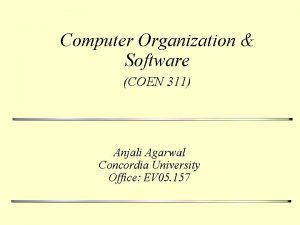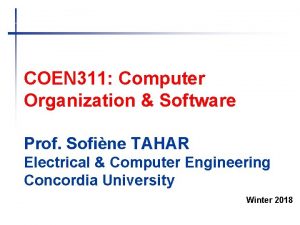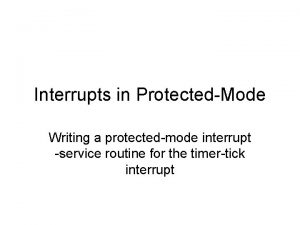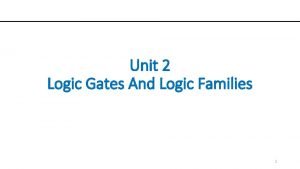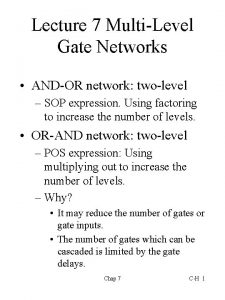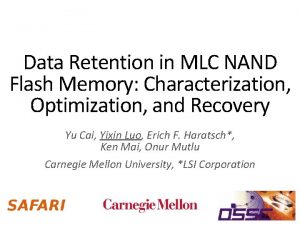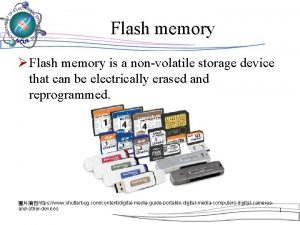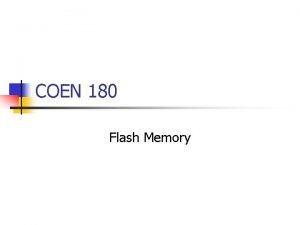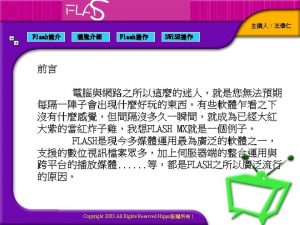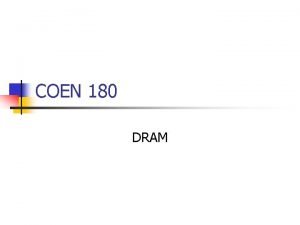COEN 180 Flash Memory Floating Gate Fundamentals Floating




















- Slides: 20

COEN 180 Flash Memory

Floating Gate Fundamentals Floating Gate is isolated. Floating gate not charged: Functions like normal MOSFET Floating gate charged: Charge shields channel region from control gate and prevents the formation of a channel between source and drain

Floating Gate Fundamentals n Charging / Discharging Floating Gate: n n n Channel Hot Electron Injection Fowler-Nordheim Tunneling Both approaches use high voltages for operations

Floating Gate Fundamentals n F-N Tunneling n Usage n n Used for erasing (removing charge) Sometimes used for programming (placing charge) Quantum Mechanical Effect that allows electrons to pass from the conducting band of one silicon region to that of another region through an intervening barrier of Si. O 2. Needs a high value of the injection field ~10 MV/cm

Floating Gate Fundamentals n Channel Hot Electron Injection (CHEI) n Usage n n n Sometimes used for programming (placing charge) Hot Carrier injection occurs when the electrons are accelerated high enough to surmount the Si. O 2 barrier Sometimes facilitated with a separate injection gate.

Floating Gate Metal Oxide Semiconductor FAMOS Structure

Stacked Gate Avalanche Injection Type MOS (SAMOS

Array Designs n Different Array Designs n n n NOR (used) NAND (used) AND DINOR T-Poly

NOR Array Reading: Assert a single word line. The source lines are asserted and the read of the bitline gives the contents of the cell.

NOR Array ul: High Voltage Source Erase ur: Negative Gate Source Erase ll: Channel Erase lr: Programming

NOR Array Erasure: Set sources to 12 V Set word lines to Ground

NOR Array Write: Set sources to 12 V Set source line to -5 V

NAND Array n n n NAND array cell is much smaller than NOR cell. Arranged in a line of typically 16 gates. NAND cell has threshold voltage higher than 0 V if programmed and a negative threshold voltage otherwise.

NAND Array n Read n n Cell to be read has grounded selected word line. Other cells have unselected level of 4. 5 V If the selected cell is programmed, then the cell is not conductive. If the selected cell is erased, then the cell is conductive.

NAND Array n Programming n n n Uses F-N tunneling. Substrate is grounded. High voltage on wordline.

NAND Array n Erasure n n Substrate is charged with 1921 V. Control gate is grounded.

NAND vs. NOR Layout n n n NAND arrays have densities at which there are more errors. Programming NAND through F-N takes longer (200 sec) per cell However, NAND is programmed in parallel, whereas NOR is programmed one bit at a time.

NAND vs. NOR Layout n n n NAND is read per page (512 B) NOR is read individually. Both erase blocks (8 KB – 64 KB) Using NAND is closer to using disk Using NOR is closer to using RAM

Multi-Levels n n By charging the floating gates at different levels, a single cell can store multiple data, typically 2 b. These correspond to different threshold values at which the gate becomes conductive.

Multi-Levels n By using reference cells set at given levels and comparing them to the value from the bitline, we can determine the value stored.
 Digital photography with flash and no-flash image pairs
Digital photography with flash and no-flash image pairs Coen 6501
Coen 6501 Coen 311 concordia
Coen 311 concordia Coen 445
Coen 445 Lab 3: smtp lab
Lab 3: smtp lab Coen 445
Coen 445 Coen 352
Coen 352 Coen 311
Coen 311 Floating gate transistor animation
Floating gate transistor animation Pmtimer
Pmtimer Not gate boolean expression
Not gate boolean expression Nand gate to and gate
Nand gate to and gate All blocks
All blocks Fujio masuoka
Fujio masuoka Nanoelectronics
Nanoelectronics Uil storytelling tips
Uil storytelling tips What is memory driven computing
What is memory driven computing Nand
Nand Nand flash data retention time
Nand flash data retention time Ememory
Ememory Primary memory and secondary memory
Primary memory and secondary memory


